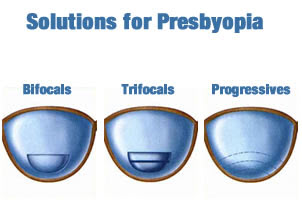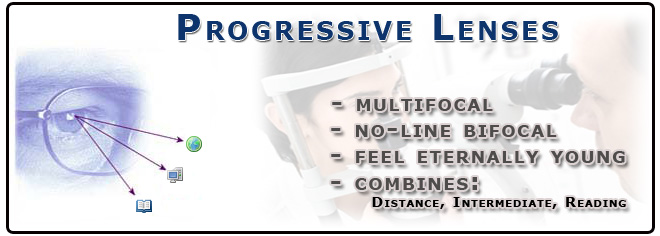When we picture older folk from a couple of decades ago, chances are we think of them wearing glasses with what seems like two different lens areas. Commonly known as bifocals, these are eyeglasses that allow people suffering from presbyopia to see better in all conditions. Presbyopia is a condition in which a person is not able to clearly see objects both near and far from the eyes. Basically, it’s a combination of myopia and hypermetropia, or simply, nearsightedness and farsightedness.

As we get older, our eyes tend to weaken, and most people over the age of 40 will need eyeglasses either for reading, or to see objects far off. If you’re blessed with great eyesight, you can probably go without glasses for longer, but somewhere down the line you will need to get a pair. Usually, people over the age of fifty tend to develop presbyopia, and the only solution to this used to be getting a pair of bifocals. While it solved the problems associated with presbyopia, it wasn’t exactly the most elegant solution, and didn’t provide the best optical experience.

Bifocals are basically just two lenses fused together, with one part helping you see objects closer to you, and the other helping you see objects far off. There’s always a clear distinction between these vision fields, and there are regions from which neither objects close by nor further off are clearly visible. This, of course, was a problem in itself, but there’s also the fact that bifocals don’t look too great.
Then came progressive lenses, a revolutionary way for presbyopia sufferers to see the world naturally and seamlessly, without having to change glasses or peer over a certain part of the glasses. Progressive lenses are lenses that blend multiple vision fields without having a clear demarcation, and allow users to read and see far off objects without much discomfort. Basically, the power in the lenses ‘progressively’ changes from one region to another, so that the change in power is not drastic. This means that middle distance vision, unlike in bifocals, is much better and you don’t need to consciously try to look out of a particular region of the lenses for optimum vision.

Since there are no ‘lens lines’ separating the different regions of the lenses, progressive lenses are also sometimes called ‘no line bifocals’ or ‘no line trifocals’. Progressive lenses are made specifically for each user, after a careful series of tests to understand where his or her vision is lacking. This is to ensure the most natural transition in looking at objects at different distances. So the lenses have to be made in such a way that each region of different focal lengths blends together in the most natural way possible. For the user, this means that he or she can simply move his or her eyes upwards to look at objects further off, downwards to look at objects close by, and straight ahead for objects at distances in between. It will probably take a little while before you get used to progressive lenses if using them for the first time, but once you do get used to them, there’s no going back!
All round vision is greatly improved with a well-made pair of progressive lenses, and it’s probably the closest a presbyopic person can get to naturally perfect vision. Users have complained of a little difficulty with peripheral vision, but that’s just something to get used to, since the lens regions are spread according to direct vision. This problem is often also solved by simply using larger lenses, hence increasing the field of vision. No matter what though, it will take time to get used to progressive lenses, and since they’re made specifically according to one set of eyes, they cannot be shared.

If measurements are off or the temple arms aren’t properly aligned, you may end up looking out through the wrong part of the lenses, which may result in blurred vision and visual discomfort. So it’s very important to get everything measured and fixed perfectly before you start using glasses with progressive lenses. Compared to bifocals, they may be a little more expensive, but you’re getting a whole bunch of advantages as well, such as:
- No visual ‘jumps’ while looking out of the demarcated areas on bifocals.
- Natural or close to natural vision.
- Tailored to specific user problems.
- Helps you look more youthful, as bifocals have traditionally been associated with old age.
Don’t worry about the adjustment period either, because all you need to do is follow the steps mentioned below, and you’ll not feel anything out of the ordinary while wearing glasses with progressive lenses. What you need to do is:

- Wear your eyeglasses with the progressive lenses immediately and continuously.
- Stop wearing your old eyeglasses.
- Wear your eyeglasses with the progressive lenses as close to your face as possible, do not keep them at the top of your nose.
So there you have it, all you need to know about progressive lenses! While progressive lenses may have been prohibitively expensive a couple of years ago, they have become more affordable in recent times, but are still more expensive than bifocals. Our thoughts? Go for the best quality progressive lenses despite the increased cost, because the visual comfort they offer are simply leagues ahead of bifocals, and it doesn’t hurt that they look far better either, does it?
Image Credits: ilookglasses.ca, coloradoophthalmology.com, stantonoptical.com, simplyeyeglasses.com, framesdirect.com
